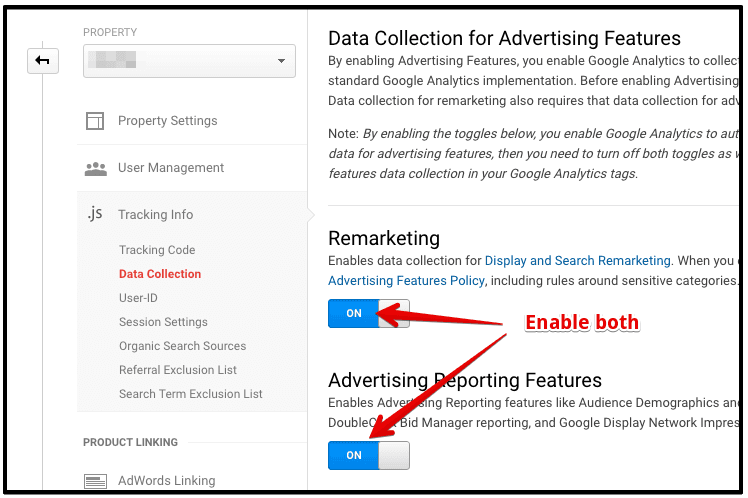Key Attributes of Remarketing In Google Analytics Explained
Key Attributes of Remarketing In Google Analytics Explained
Blog Article
Effective Approaches for Remarketing in Google Analytics
In the world of digital advertising and marketing, the realm of remarketing in Google Analytics stands as a pivotal tool for companies aiming to enhance their online visibility and conversion prices. Through tactical audience division, customized remarketing checklists, and interesting ad creatives, businesses can craft tailored campaigns that resonate with their target market. However, truth success hinges on the capability to constantly improve and maximize these methods based upon performance metrics and data insights. By discovering the nuances of vibrant remarketing and leveraging innovative tracking tools, organizations can open the full potential of their remarketing initiatives, leading to increased brand presence and customer interaction.
Audience Division
Using audience division is a pivotal approach in optimizing the effectiveness of remarketing projects within Google Analytics. By dividing your audience right into unique teams based on their habits, demographics, or passions, you can customize your advertising messages to be much more relevant and engaging. This approach enables you to deliver individualized advertisements to details sections, enhancing the likelihood of conversion.

Moreover, target market segmentation assists you understand the differing needs and choices of various consumer teams, allowing you to craft even more engaging ad creatives and offers. This targeted approach not only boosts the performance of your remarketing efforts but also boosts total campaign efficiency.
Establishing Remarketing Lists
To properly implement remarketing strategies in Google Analytics, the first step includes developing targeted remarketing listings based on particular target market communications. Establishing remarketing checklists enables marketing professionals to section their internet site visitors into various groups based upon their actions, such as web pages seen, items searched for, or activities handled the website. By specifying these sectors, marketers can then create pertinent and tailored advertisements that target these particular groups, raising the possibility of conversion.
Remarketing listings can be established up making use of numerous requirements such as web page visits, period of visit, certain goal completions, or even specific occasions triggered on the internet site. This degree of modification allows marketers to tailor their advertisements to match the passions and choices of each segmented target market, bring about greater interaction and conversion rates.
Furthermore, remarketing checklists can likewise be produced based on data imported from various other resources like CRM systems, permitting a lot more exact targeting. By establishing these targeted remarketing listings, online marketers can properly reach out to potential customers who have currently shown interest in their services or products, taking full advantage of the effect of their remarketing projects.
Creating Engaging Ad Creatives
After segmenting web site site visitors right into targeted remarketing listings based upon specific audience communications, the following vital step is to craft engaging advertisement creatives that reverberate with each fractional group's preferences and interests. The performance of remarketing projects greatly counts on the ability of these ad creatives to catch the focus of the target market and drive them to take the desired activity.
To create engaging advertisement creatives, it is necessary to recognize the special attributes of each fractional group (What Is “Remarketing” In Google Analytics?). Customizing the messaging, visuals, and uses to straighten with the rate of interests and choices of the target market can significantly boost the chances of conversion. Making use of vibrant ads that automatically change material based on the customer's behavior can likewise improve the customization of the ad experience

Surveillance Performance and Optimization
Reliable monitoring of project efficiency and continuous optimization are vital elements of effective remarketing strategies in Google Analytics. To make article certain the efficiency of remarketing projects, weblink online marketers must frequently track crucial efficiency metrics such as click-through rates, conversion rates, and return on ad invest. By monitoring these metrics, marketing experts can acquire important insights right into the efficiency of their projects and determine areas for improvement.
In Google Analytics, marketing professionals can take advantage of devices like conversion tracking and target market segmentation to assess the efficiency of their remarketing campaigns. Conversion tracking enables marketing experts to track particular activities that customers take after clicking on a remarketing ad, providing beneficial data on the efficiency of the project in driving desired results. Target market segmentation, on the other hand, makes it possible for marketers to split their target market into different segments based on various requirements such as demographics, behavior, and rate of interests, enabling more targeted and customized remarketing efforts.
Constant optimization is vital for making best use of the effect of remarketing campaigns. Marketing professionals need to make use of A/B testing to trying out various advertisement creatives, messaging, and targeting methods to recognize one of the most effective approaches. By routinely assessing campaign performance data and making data-driven optimizations, marketing professionals can make sure that their remarketing projects are accomplishing the wanted results and driving conversions successfully.
Leveraging Dynamic Remarketing
Using dynamic remarketing can substantially improve the importance and effect of targeted ads in Google Analytics. This advanced strategy allows marketers to reveal individualized ads to users that have actually formerly seen their site or used their mobile app. By dynamically showing product and services that the individuals have shown interest in, dynamic remarketing helps to maintain the brand name fresh in their minds and motivates them to return to finish an acquisition.

Additionally, dynamic remarketing projects can be automated and enhanced in real-time based upon efficiency information, making certain that the ads stay relevant and effective. By leveraging vibrant remarketing in Google Analytics, marketers can produce a lot more impactful and targeted ad campaign that reverberate with their target market and drive results.
Final Thought
In conclusion, effective remarketing methods in Google Analytics involve audience segmentation, targeted remarketing checklists, compelling advertisement creatives, performance monitoring, and vibrant remarketing. By concentrating on tailored ads, data evaluation, and continual optimization, organizations can raise conversion prices and drive engagement successfully. Leveraging devices like conversion tracking makes sure that advertisements remain individualized and pertinent, resulting in overall success in remarketing efforts.
Through calculated audience segmentation, tailored remarketing lists, and engaging ad creatives, services can craft personalized projects that reverberate with their target audience. Making use of dynamic ads that automatically readjust material based on the user's behavior can also boost the personalization of the ad experience.
Conversion tracking allows marketing professionals to track certain actions that customers take after clicking on a remarketing advertisement, providing valuable data on the effectiveness of the project in driving desired results.Utilizing vibrant remarketing can substantially enhance the significance and influence of targeted advertisements in Google Analytics - What Is “Remarketing” In Google Analytics?.In conclusion, efficient remarketing approaches in Google Analytics include target market division, targeted remarketing checklists, engaging advertisement creatives, efficiency surveillance, and dynamic remarketing
Report this page